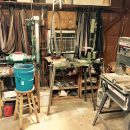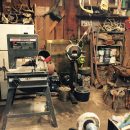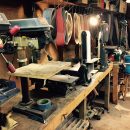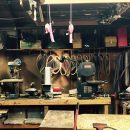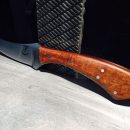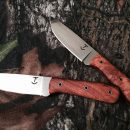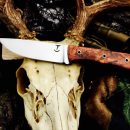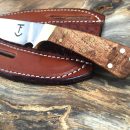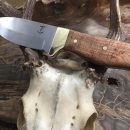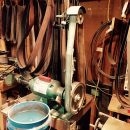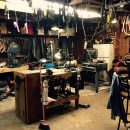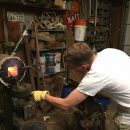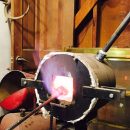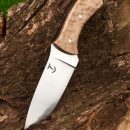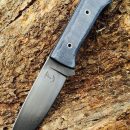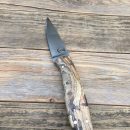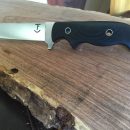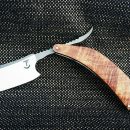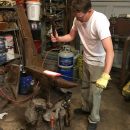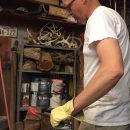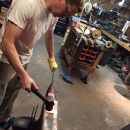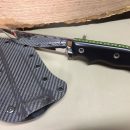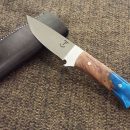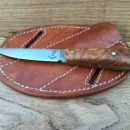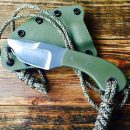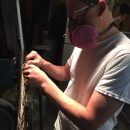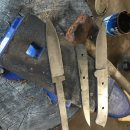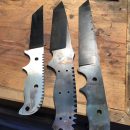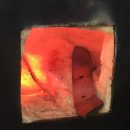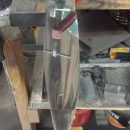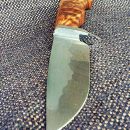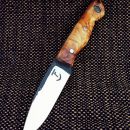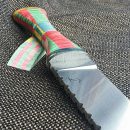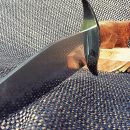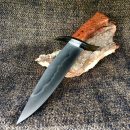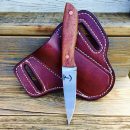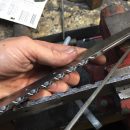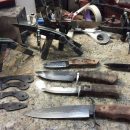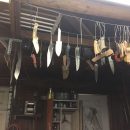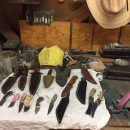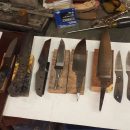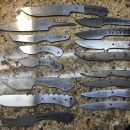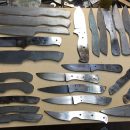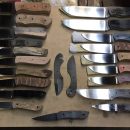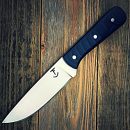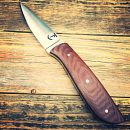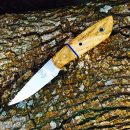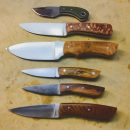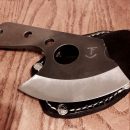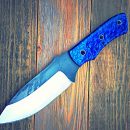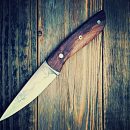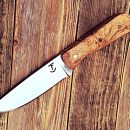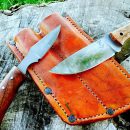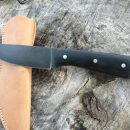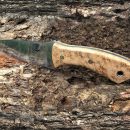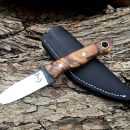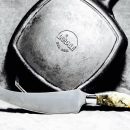Fleming’s Fabrications – The Knifemakers Series
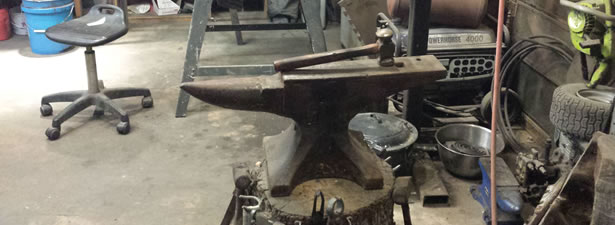
Late last year, I ran across some beautiful handmade bushcraft blades that really caught my eye while I was perusing some Facebook Groups for custom knifemakers. Each blade was crafted by the custom knife fabricator, Travis Fleming of Fleming’s Fabrications. On this edition of Knifemakers From Around the World, not only will I be interviewing Travis about his work, I also get one of his beautiful custom knives in my hands to do some knife stuff… Check it out here.
Fleming’s Fabrications is a small one-man operation located deep in Northern Texas in a town named Greenville. Most of their knives are hand-forged from quality high carbon steel alloys like 1084, 1095, O1 and 80CRV2 depending on the purpose of the design. However, when they do make stainless steel blades, they are typically made from a 440C, CPM154 or AEBL alloys. All of their blades are hand-ground and heat-treated completely in-house as well.
Living in Texas, Travis is able to procure most of the handle materials himself from an abundance of beautiful local wood including Mesquite, Hackberry, Osage Orange and Pecan. He also stabilizes all of the handle material that he uses himself, and he is currently working on a line of synthetics.
Now for a little Q & A…
Do you make anything other than knives?
I’ve always dabbled in metal fabrication in one form or another. However, as more orders for knives keep rolling in, I find that I have less and less time for making anything else.
What are your favorite knives and knife styles?
I’m kind of old school in my taste for knives. I also enjoy being in the outdoors (hunting and fishing). So my taste for knives tends to follow what I find useful in the outdoors. For a hunting knife, the Loveless Drop Point is a hard to beat design. For a skinning knife, the Schrade Sharpfinger is an extremely useful design. For a pocket knife it doesn’t get much better than a classic two blade trapper. Sure, there are flashier and newer designs out there that are great in their own right, but I’m a sucker for some of the classic designs.
What is your Every Day Carry?
When I’m not at my day job I rotate several different knives on a continual basis. I have a standard EDC model in my lineup and that seems to be the one I wear the most. The one I wear is nothing fancy, just O1 tool steel and Birdseye maple in a cross draw sheath. I usually have a case trapper in my pocket as well.
Have you considered making blacksmithing/knifemaking your full-time gig?
I would love to go full time at some point in the future. I know that it is a long shot, but the thought of being my own boss is very appealing. In the meantime I will just focus on building on my Customer base and learning new skills. I figure that if I can continue to make my customers happy while increasing my skills, the rest will take care of itself.
Please share with us a little about your shop…
My shop is a detached garage at my house. It’s certainly nothing fancy but it gets the job done. I first started with some files and sandpaper in a lean to shed. Although I don’t yet have a fully outfitted shop with all the bells and whistles, it’s a long way from where I started.
Which industry shows do you attend?
I attend several gun and knife shows in the Texas area. I am hoping to start attending more Knife oriented shows in the near future such as the annual Blade show.
What handle/scale materials do you like to work most?
In Texas, we are covered with this ball of thorns called a Mesquite tree. It is a very dense hardwood that has good stability. It finishes beautifully and when you find a good piece of Burl, I am convinced that there is not a prettier wood out there. I spend a good bit of time every year walking through the mesquite brush with my chainsaw in hand looking for good burl knots to add to my collection of handle materials. I’m also a fan of Micarta. It is extremely durable and makes for a good heavy use knife.
What do you like most about making custom knives?
That’s simple, the finished product. Sometimes a certain design or style will give you fits the entire time you are building the knife. It’s all worth it though when you are looking at the final product. Seeing a finished knife that started as just some raw materials is extremely gratifying.
What do you like least about making custom knives?
I would say that finding a balance between my family time and knives. Like a lot of Custom makers out there, I work a full time job and then come home to work on knives as a second job. My family is the most important thing in my life. They are also the reason I work as hard as I do. Trying to balance out time with my family and getting out Customers orders is a difficult task and one that I have not fully mastered yet.
What tools do you use most in your shop?
That would most definitely be the knife grinder. A large portion of my time is spent here. Second would be the forge and anvil.
Who are your favorite knife makers and bladesmiths?
I could go on forever listing knife makers, but to name a few; Claudio Sobral, Daniel Pica, Troy Hawley, Dustin Williams, Johnny Stout, and Spencer Aplin are all on the front lines when it comes to creating innovative designs with stunning looks. Bottom line is that there are a lot of talented knife makers on the knife scene these days.
Who in the industry has influenced you the most?
When I first wanted to get into knife making, I ordered the book “How to Make Knives” with Bob Loveless. I was infatuated with his work. I still look at some of his knives as the Holy Grail of handmade knives. I would consider him a big influence in my desire to be a knife maker. There are other makers out there that make certain designs and styles that I really like and that drive me to try and build a knife at their level. Nick Wheeler’s Bowie knives come to mind.
It seems like every knife maker has some new skill that they are trying to learn. You?
I have been working more on making San Mai layered steel and making my own Damascus. Although the process has proven to be very demanding, it has also been very rewarding. I am also working on some slip-joint designs and hope to have some of my first folding knives available by the end of the year.
What was the hardest lesson to learn related to making knives?
Although there is a lot of knowledge to be found online, you need to be careful with the info you come across. There is a lot of bad information being put out there to the new knife maker. For example, the internet is filled with people stating the O1 tool steel is a great starter steel and easy to heat treat. I am not sure where this idea started but it keeps getting regurgitated as if it were true. Yes, you can make a “usable knife” with it using minimal equipment but with its alloying content you really need a good heat treat oven to reach its full potential. You would be better off using a simple steel like 1084-1075. These steels can reach their full potential with a basic forge setup. Why spend double the money for O1 when a better overall blade can be made at half the price? The same can be said for 1095 needing a fast quench oil. These were some lessons I had to learn the hard way. You have to be careful what info you get from the internet.
Have you ever been injured in the shop?
Too many times to count. For that reason, I won’t even sharpen a knife until it’s on its way to the Customer. Sure, the tools and equipment can cause injury as well, but most of mine have come from sharp blades.
What advice would you give someone trying to get into knife making?
Always start with a known steel and use a tried and true method of heat treating. There is a lot of misinformation out there. If in doubt on the heat treat method, contact the manufacture of the steel. They have spent plenty of time analyzing how to get the best possible heat treat out of their steel.
Do you have any tips that you can share?
Simple. Don’t let a knife out of your shop if you’re not happy with it.
Travis, thank you so much for opening up your shop and taking the time to do this Q&A session with us… We really appreciate the opportunity. It was a pleasure to learn more about your craft and how you’ve carved out your spot in a large crowd of custom knifemakers. Especially for those who are break into the craft.
Be sure to check out more of Travis’s work on the Fleming’s Fabrications Facebook page and the website, www.flemingsfabrications.net.
…And now onto the review of the Bushcrafter!
--
